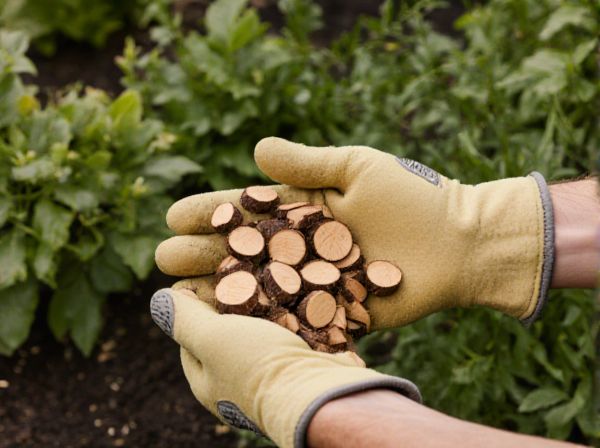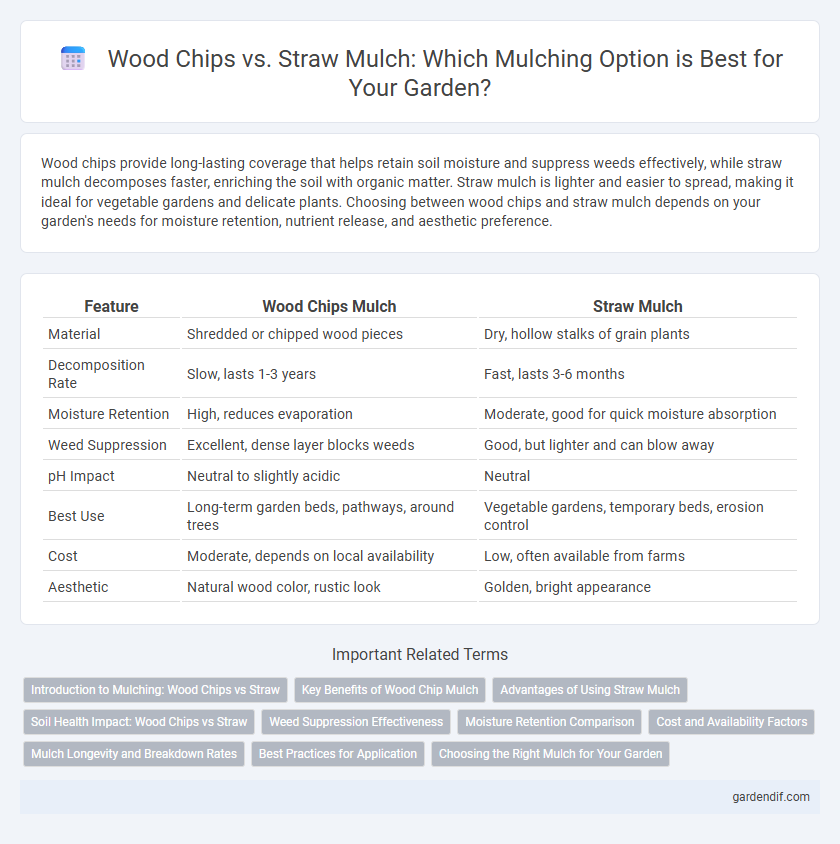
Wood Chips vs Straw Mulch Illustration
Wood chips provide long-lasting coverage that helps retain soil moisture and suppress weeds effectively, while straw mulch decomposes faster, enriching the soil with organic matter. Straw mulch is lighter and easier to spread, making it ideal for vegetable gardens and delicate plants. Choosing between wood chips and straw mulch depends on your garden's needs for moisture retention, nutrient release, and aesthetic preference.
Table of Comparison
| Feature | Wood Chips Mulch | Straw Mulch |
|---|---|---|
| Material | Shredded or chipped wood pieces | Dry, hollow stalks of grain plants |
| Decomposition Rate | Slow, lasts 1-3 years | Fast, lasts 3-6 months |
| Moisture Retention | High, reduces evaporation | Moderate, good for quick moisture absorption |
| Weed Suppression | Excellent, dense layer blocks weeds | Good, but lighter and can blow away |
| pH Impact | Neutral to slightly acidic | Neutral |
| Best Use | Long-term garden beds, pathways, around trees | Vegetable gardens, temporary beds, erosion control |
| Cost | Moderate, depends on local availability | Low, often available from farms |
| Aesthetic | Natural wood color, rustic look | Golden, bright appearance |
Introduction to Mulching: Wood Chips vs Straw
Wood chips and straw are popular mulch options, each offering distinct benefits for soil health and plant growth. Wood chips decompose slowly, providing long-lasting weed suppression and moisture retention, while straw mulch breaks down faster, enriching the soil with organic matter more quickly. Selecting between wood chips and straw depends on crop type, garden aesthetics, and specific nutrient requirements.
Key Benefits of Wood Chip Mulch
Wood chip mulch provides long-lasting moisture retention and effectively suppresses weed growth by creating a dense barrier, which improves soil health by gradually decomposing and adding organic matter. Its coarse texture enhances soil aeration and drainage, fostering robust root development for plants. Wood chips also help regulate soil temperature, protecting roots from extreme heat or cold throughout different seasons.
Advantages of Using Straw Mulch
Straw mulch offers excellent moisture retention and weed suppression due to its dense, interwoven structure, which helps reduce soil erosion and maintains a stable soil temperature. It decomposes rapidly, enriching the soil with organic matter and beneficial nutrients, enhancing soil fertility naturally. Lightweight and easy to apply, straw mulch is also cost-effective, making it ideal for large garden areas and agricultural use.
Soil Health Impact: Wood Chips vs Straw
Wood chips contribute to improved soil aeration and water retention by slowly decomposing and enriching organic matter, while straw mulch primarily enhances moisture conservation and prevents soil erosion. Wood chips, with higher lignin content, support beneficial fungal growth that boosts nutrient cycling, whereas straw mulch decomposes faster, providing a quicker release of nutrients but with less structural soil improvement. Both mulches promote soil health, yet wood chips offer long-term soil structure benefits, and straw mulch benefits are more immediate but short-lived.
Weed Suppression Effectiveness
Wood chips provide superior weed suppression by forming a dense, durable layer that blocks sunlight, preventing weed germination more effectively than straw mulch. Straw mulch decomposes faster and is lighter, allowing more light and weed seeds to penetrate the soil surface. Gardeners seeking long-lasting weed control benefit most from wood chip mulch due to its thicker coverage and slower decomposition rate.
Moisture Retention Comparison
Wood chips provide superior moisture retention compared to straw mulch due to their denser composition, which reduces evaporation and keeps soil consistently hydrated. Straw mulch, while lighter and more breathable, tends to dry out faster, requiring more frequent watering to maintain optimal soil moisture levels. Research shows that wood chips can retain up to 30% more moisture over a two-week period, enhancing plant growth and drought resilience.
Cost and Availability Factors
Wood chips typically cost more than straw mulch due to processing and sourcing requirements, but they offer longer-lasting coverage that reduces replacement frequency. Straw mulch is often cheaper and more readily available in agricultural regions, making it a cost-effective option for large-scale gardening and farming. Availability of wood chips depends on local tree trimming and lumber industry byproducts, while straw supply fluctuates with harvest seasons and crop yields.
Mulch Longevity and Breakdown Rates
Wood chips generally offer greater mulch longevity compared to straw mulch due to their dense, coarse texture that decomposes slowly over several months to years. Straw mulch breaks down faster, typically within a few weeks to a couple of months, enriching the soil quickly but requiring more frequent replacement. Choosing wood chips extends ground cover and weed suppression duration, while straw mulch benefits rapid nutrient cycling and soil improvement.
Best Practices for Application
Wood chips and straw mulch each offer distinct benefits for soil protection and moisture retention; wood chips decompose slowly, making them ideal for long-term coverage, whereas straw mulch breaks down quickly, providing rapid nutrient release. For best practices, apply wood chips in a 2-4 inch layer around trees and shrubs to suppress weeds and regulate soil temperature, while straw mulch should be spread thinner, about 1-2 inches, to avoid matting that restricts water infiltration. Properly managing mulch depth and ensuring it does not contact plant stems prevents disease and pest issues, maximizing the effectiveness of both wood chips and straw in garden and landscape applications.
Choosing the Right Mulch for Your Garden
Wood chips provide long-lasting mulch with excellent weed suppression and moisture retention, ideal for trees and perennial beds. Straw mulch offers quick soil warming and decomposes faster, enriching garden soil and benefiting vegetable gardens and annuals. Selecting the right mulch depends on plant type, soil condition, and garden goals, balancing durability with nutrient needs.
Wood Chips vs Straw Mulch Infographic

 gardendif.com
gardendif.com